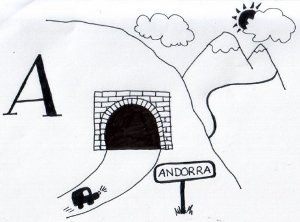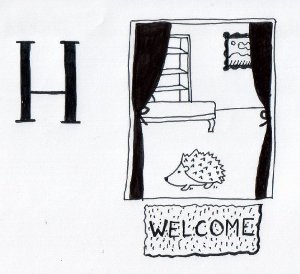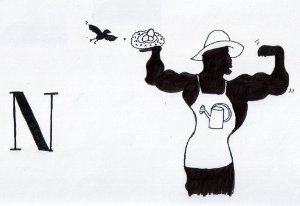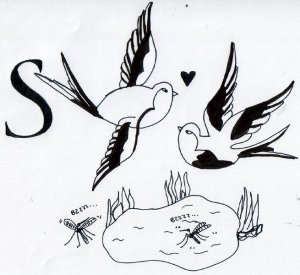Little boys’ & girls’ alphabet
15 août 2010 11:39 0 messages
Let us talk !
We started with a warming-up moment, by telling out a very short story : each of us had to say at least one funny (funny-ahah or funny-peculiar) story which happened recently to a friend, a member of one’s family or oneself. We talked about :
- running out of gas,
- getting blisters when riding,
- a hedgehog,
- a couple of lizards,
- a nest of swallows,
- a trip to Andorra
Let us work !
We discovered and commented an American alphabet primer of the 19h century. The 26 pictures were found on Baldwin Library’s Alphabet Book Number 47.

- Front page
We tried, each in turn, to read aloud, from A to Z, the twenty-six stanzas linked to each of the letters, in the alphabetic order.
![]() We focused at first on the pronunciation and the tonic accents in order to reproduce the music of those limerick-like quatrains.
We focused at first on the pronunciation and the tonic accents in order to reproduce the music of those limerick-like quatrains.
For example, for the twenty-fifth letter :

- Y is a Yacht...
- Try to stress the proper following syllabes and find out the crossed rhymes.
Y is a Yacht / Sailing out / on the sea // If we were / on board // How Happy / we’d be //
![]() The general meaning was understood. We only started clearing out the problematic details at that moment, in English of course : Why "out" (sailing out), "on" (on board), "’d" (we’d be)...
The general meaning was understood. We only started clearing out the problematic details at that moment, in English of course : Why "out" (sailing out), "on" (on board), "’d" (we’d be)...
![]() Then the picture illustrating the stanza and the letter was shown and commented ; sometimes it helped with the meaning, sometimes it induced more questions, on vocabulary for example :
Then the picture illustrating the stanza and the letter was shown and commented ; sometimes it helped with the meaning, sometimes it induced more questions, on vocabulary for example :
- what’s the name of the buoy ? lightbouse ? race ?

- YACHT
![]() Finally, we turned back to the text and re-read it, and eventually translated it.
Finally, we turned back to the text and re-read it, and eventually translated it.
Let us write
Once back home, we tried to write down stanzas of our own with our short stories. Here is what we produced ! the result of this assignment :
ANDORRA-LA-VIEILLA
Where both cousins will go shopping
This week-end
After driving through the tunnel so scaring.

- ANDORRA nous voilà !
B for the BLISTERS on the heels
He got riding his bike
Without socks in his shoes,
And the special dressing he got from his friend.

- BLISTERS and BIKE
H for the noisy HEDGEHOG
Who softly entered our room last night
But thoroughly brushed his spines
On our coco doormat, when leaving.

- HEDGEHOG in search of a scratching girl-friend
N for the blackbirds’ NEST full of brown eggs
Gently moved from my neighbours’ hedge
By their courteous gardener
Into my own troughs, so cute he said.

- NEST ON THE MOVE
P for Lily goes to the PSY,
from the title of the book
Ann brought to her grand-daughter,
After running out of gas on her way down there.
S for the faithful couple of SWALLOWS
Who came back nesting for the second time
To our wooden beam,
And fed themselves with mosquitoes from our pond.

- HUNGRY SWALLOWS
G from GRIBOUILLE this rascal Puss of ours,
Slyly hiding up in the staircase,
Who swiftly scratches through the steps
Whatever hair passes by underneath.
L for the friendly couple of LIZARDS
Who settled in our patio window-box
And steadily took on a job of fly-watchers
All year round.
C for CHARLES and E for EDWARD
Not the first names of Elisabeth’s sons
But of my friendly lizards !
You can easily recognize them :
Charles has blue eyes
But, brown eyes has Edouard !
NB. Thanks Mary for these drawings
Let us go further
A bit of historical context
Alphabet Books are designed to teach children the letters of the alphabet.
From the medieval period until the 18th century they were closely associated with catechisms, primers and other books of instruction, but by the 18th century the alphabet was also being taught in books intended to amuse as well as instruct and included pictures of objects which began with the letter being introduced.
Illustrated alphabet books based on various subjects, such as animals, birds, scripture and children’s names were popular in 19th century England and America.
An opportunity to open en.Wikipedia
Alphabet books introduce the sounds and letters of the ordered alphabet. These books provide a non-threatening genre in which children engage in a variety of both fiction and non-fiction texts. Alphabet books provide opportunities for :
- Developing conversations and proficiency in oral language
- Increasing phonemic awareness
- Teaching phonics
- Making text connections (Activating prior knowledge)
- Predicting (Text talk)
- Building vocabulary
- Inferencing / drawing conclusions
- Sequencing
- Identifying elements of story structure
- Recognizing point of view
- Visualizing setting (Time, place and atmosphere)
- Writing (Converse, Compose, Create : Poetry and narrative stories)
- Performing Dialogue (Plays and Readers’ Theater)
- Rereading for fluency
- Retelling for comprehension checks
- Engaging Multiple Intelligences through writing, music, art, Dance.
Ouah !!! Fifteen proficiencies through this child-like activity ???
to go further
Dans la même rubrique
20 août 2010 – Talk versus gossip
19 août 2010 – Deep into Alice’s burrow
16 août 2009 – Là-haut





